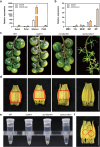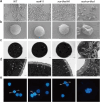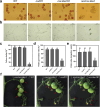Functional redundancy of transcription factors SlNOR and SlNOR-like1 is required for pollen development in tomato
- PMID: 40078722
- PMCID: PMC11896966
- DOI: 10.1093/hr/uhaf003
Functional redundancy of transcription factors SlNOR and SlNOR-like1 is required for pollen development in tomato
Abstract
In tomato, SlNOR and SlNOR-like1, members of the NAC family of transcription factors (TFs), are known to play critical roles in regulating fruit ripening and are highly expressed in floral organs. However, their role in flower development remains unclear. In this study, we generated and functionally characterized a double knockout mutant, nor/nor-like1. Our findings reveal that the pollen abortion of the nor/nor-like1 impedes ovarian enlargement, resulting in fruit formation failure. Histological analyses demonstrate that the pollen wall collapse occurs during the mature pollen stage and leads to the abnormal pollen wall component deposition at the microspore stage, resulting in the male sterility in the double knockout mutant lines. Kyoto Encyclopedia of Genes and Genomes enrichment pathway analyses further suggest that the loss of SlNOR and SlNOR-like1 function affects several metabolic pathways related to pollen development, including 'ABC transporters', 'lipid metabolism', 'phenylpropanoid biosynthesis', 'hormone signal transduction', 'starch and sucrose metabolism', and 'cutin, suberine, and wax biosynthesis'. Furthermore, our results demonstrate that SlNOR and SlNOR-like1 could directly bind to the promoters of key genes associated with pollen wall formation and activate their expression, including ATP-binding cassette transporters of the G family (SlABCG8/9/23), ECERIFERUM (SlCER1), and glycine-rich protein (SlGRP92). These findings suggest that SlNOR and SlNOR-like1 may play a redundant role in the biosynthesis and transport of sporopollenin precursors, cuticular wax biosynthesis, and exine formation. In summary, our study highlights a previously uncharacterized role of SlNOR and SlNOR-like1 in tomato pollen wall formation and male fertility.
© The Author(s) 2025. Published by Oxford University Press on behalf of Nanjing Agricultural University.
Conflict of interest statement
No conflict of interest declared.
Figures







References
-
- Dresselhaus T, Franklin-Tong N. Male-female crosstalk during pollen germination, tube growth and guidance, and double fertilization. Mol Plant. 2013;6:1018–36 - PubMed
-
- Xu Y, Jiang J, Huang S. Arabidopsis actin-depolymerizing factor10 depolymerizes apical actin filaments to facilitate pollen tube turning in response to female attractant. Seed Biol. 2024;3:e015
-
- Wang WQ, Meng JG, Yang F. et al. A non-defensin peptide NPA1 attracts pollen tube in Arabidopsis. Seed Biol. 2024;3:e003
-
- Brukhin V, Hernould M, Gonzalez N. et al. Flower development schedule in tomato Lycopersicon esculentum cv. Sweet cherry. Sex Plant Reprod. 2003;15:311–20

